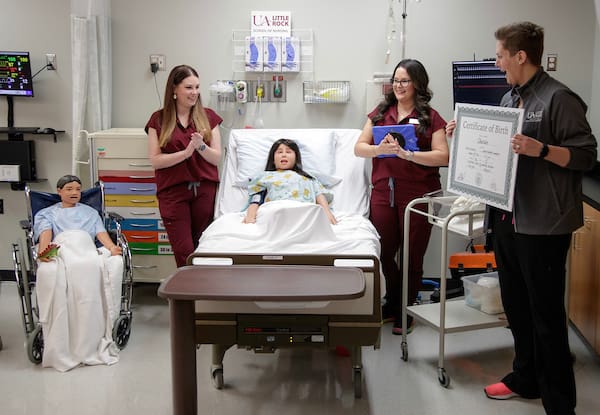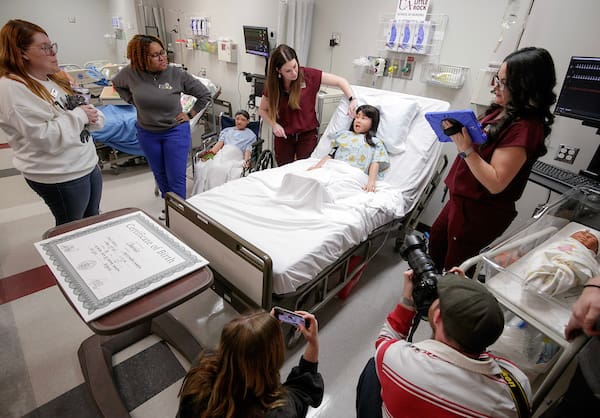UA Little Rock Unveils New Advanced Pediatric Manikin for Nursing

The UA Little Rock School of Nursing has welcomed a special addition to the Center for Simulation Innovation, a new pediatric manikin that will help nursing students and professionals train for a variety of health care scenarios involving young children.
Worth about $85,000, this high-fidelity pediatric manikin, CAE Aria, represents a 7-year-old child and prepares students and practicing professionals for the moments that count. Training with CAE Aria reduces medical errors, improves performance, and enhances pediatric patient care.
The School of Nursing had to wait almost as long as a real-life pregnancy, approximately nine months, for the pediatric manikin to arrive due to supply chain issues, so the School of Nursing held a celebration to announce the “birth” of Charlie, complete with a birth certificate and a family of pediatric manikin siblings.
“We pulled all the pediatric manikins today to celebrate, and they’ve all got these cute little stickers that say proud big brothers and proud big sisters,” said Joanna Hall, director of simulation at UA Little Rock. “This is a big event for us. This has been years in the making. We are really trying not only to put simulation on the map for our Simulation Center but to give our students a unique experience here at UA Little Rock that they’re not going to get anywhere else in the state.”
Charlie will be used in a variety of training scenarios from oxygenation issues such as asthma or anaphylaxis to infection, perfusion, or neurological issues. Simulation staff can change Charlie to meet a wide range of simulation training needs. They can change the manikin vital signs, including heart rate and rhythm, blood pressure, respirations, and pulse oximetry. Charlie can also bleed, urinate, have seizures, and the eyes can change to appear bloodshot, jaundiced, or numerous other presentations.
“The options for this manikin are endless,” Hall said. “This manikin looks infinitely more realistic than many of the other similar, lower fidelity manikins we currently have. In addition to looks, this new peds manikin feels real with silicone skin, compared to the plastic skin of our older pediatric manikins. Beyond appearance and realism, the technology our new peds manikin has is night and day better than our older peds manikins. Charlie is completely wireless which adds to the realism of the experience and is completely run off a Microsoft Surface tablet, which can change every aspect of the manikin function and presentation from vital signs and other physiological changes to age-appropriate voice responses.”
Charlie is very verbal and has a lot to say. The manikin communicates many phrases from “I want my mommy,” to “Ouch!” to “It felt like somebody was poking me with a stick.” Charlie’s communication skills help nursing students know how the patients react to different situations.
Ashley Easter, a nursing faculty adjunct, called the new manikin an exciting and cool addition to the simulation center.
“This manikin gives the students a good learning experience,” Easter said. “The other manikins are quiet, but this manikin can talk to you and tell you if it’s in pain. I like the fact that it can change genders, talk to us, and feels so real. We have many opportunities for the students to practice procedures like giving an injection, checking its pulse, and more.”
The School of Nursing received more than 30 suggestions for potential names for the manikin via Facebook. After the faculty narrowed it down to four names, nursing students voted for the winner. The other three finalists included Riley, Peyton, and Taylor.

“Our faculty have named the manikins in the past, but we wanted this to be more of an experience and a way to get our students and the community involved,” Hall said.
Paula Rocha, a senior nursing major from Little Rock, is the person who suggested the winning name of Charlie after her daughter.
“I am so excited for UA Little Rock nursing students,” Rocha said. “They get to experience this incredible technology that will turn them into safe, amazing nurses. I originally thought of the name ‘Charlie’ for the manikin because it is gender neutral and my 3-year-old is named Charlie. Charlie keeps us on our toes. She is my wild child, much like the manikins keep nursing students on their toes in sim. I think it’s the perfect fit for a pediatric simulation.”
